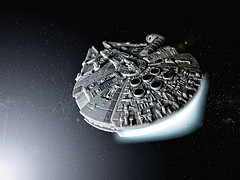
Space is vast; our current fastest spacecraft will take tens of thousands of years to get to other stars.
So fundamental breakthroughs in physics will likely be needed before it is practical to send out our first interstellar probes.
Such breakthroughs are inherently unpredictable, but here’s a hint at how one might happen: a physicist has proposed using the Large Hadron Collider to experiment on a possible propulsion method that could accelerate objects to significant fractions of the speed of light, Tech Review reports.
Physicist Franklin Felber specifically notes that high speeds “can be achieved without generating the severe stresses that could damage a space vehicle or its occupants.”
Effects on humans might be irrelevant: such a method might first be applied to very small vehicles that would send data back from other stars. Some have even proposed that tiny spacecraft could use nanotechnology to build themselves out at their destinations.
(Image courtesy Andres Rueda, Flickr — Creative Commons license)